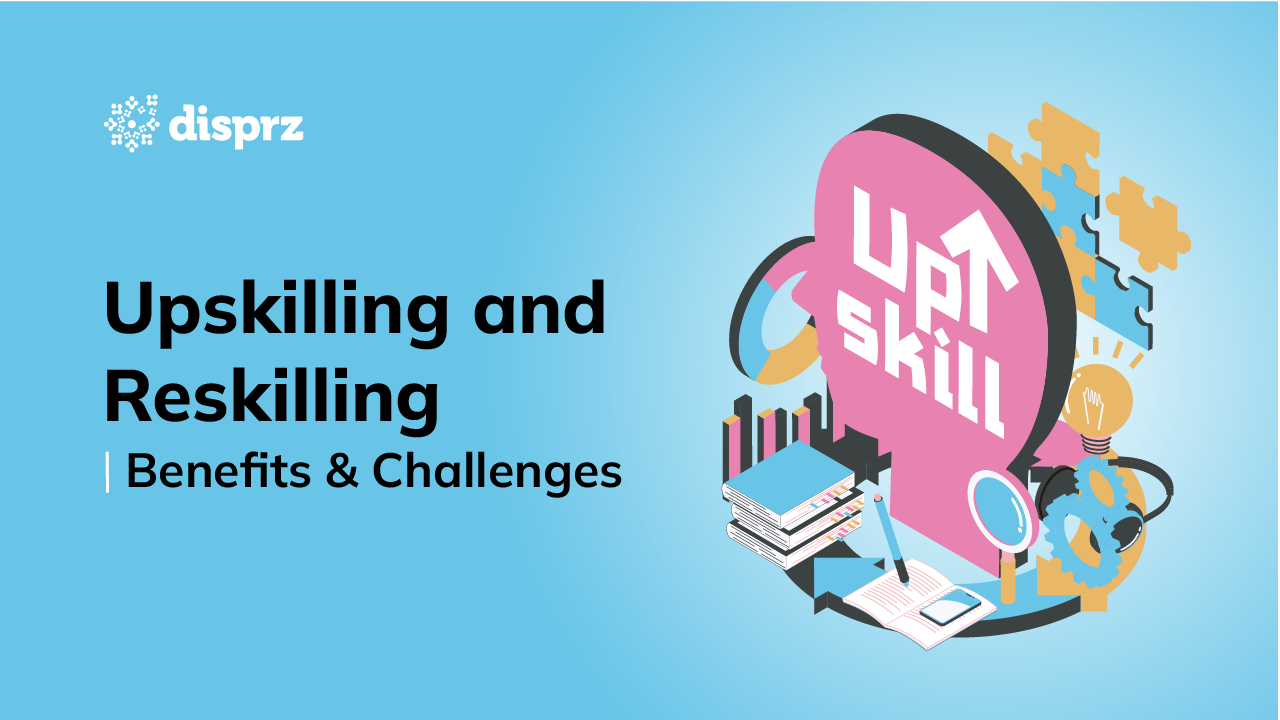According to a World Economic Forum report, by 2025, more than half of the employees globally will need to reskill or upskill.
This pressing need for employee development isn't a distant future scenario. Businesses are recognizing the necessity of preparing for shifting talent requirements and are proactively investing in upskilling and reskilling initiatives to close these skills gaps, with a notable 15% increase in organizational investments.
In this blog, we will delve into the significance of upskilling and reskilling, their profound impact on the workforce, and how these continuous learning strategies stand as foundational pillars in a forward-thinking, agile approach to both skill development and career advancement.
Upskilling and Reskilling - An Overview
While often used interchangeably, upskilling and reskilling are two distinct strategies to enhance workforce competencies.
What is Upskilling?
Aimed at expanding an individual’s skill set (both hard and soft skills) within their current role, upskilling focuses on adapting to industry advancements and enhancing performance. It is increasingly integral to performance evaluations in the contemporary work setting.
Read more about employee upskilling in the linked article.
What is Reskilling?
Reskilling is primarily about identifying and training employees with additional skills for employees for entirely new roles in order to fulfill future demands.
With the digital revolution reshaping job functions, reskilling offers career paths for internal mobility, helping businesses maintain a positive, efficient work environment while curbing employee turnover.
Read more about employee reskilling in the linked article.
Benefits of Upskilling and Reskilling
.png?width=1000&height=1213&name=2%20(2).png)
Challenges Faced by L&D Leaders to Incorporate Upskilling & Reskilling Initiatives
Ineffective skilling strategy
Without a clear plan aligning skill needs with business goals, L&D leaders struggle to create effective skilling programs for their workers. Strategy gaps hinder targeted new skill development, resulting in wasted efforts and missed opportunities for comprehensive employee growth.
Check how Disprz LXP transformed Deloitte skilling strategy and helped them achieve a 95% course completion rate.
Outdated training methods
Relying on conventional employee training and skilling methods limits engagement and relevance. These methods often lack interactivity, fail to cater to digital-native learners, offer static content, lack personalization, and overlook critical thinking development.
Limited Self-paced learning
Organizations often follow a push-based training method to impart knowledge to team members. This approach often employs a uniform curriculum, treating all learners the same, which can hinder progress by failing to accommodate individual learning styles and preferences. Additionally, it may restrict access to a finite set of resources, potentially missing out on diverse learning opportunities and personalized skill development.
Read how Disprz amplified self-paced learning at Petronas, boosting learning agility by 88%.
Hiring & Skilling program mismatch
Frequently, HR leaders and professionals in the hiring process prioritize higher educational qualifications over skills testing, resulting in a mismatch between candidates' abilities and job requirements. By neglecting skills testing, organizations may inadvertently overlook well-suited candidates without formal degrees while potentially hiring individuals with impressive academic backgrounds who lack the necessary hands-on competencies for specific positions.
6 Takeaways From IBM’s Report - Reskilling the Workforce
IBM’s insightful report – “Reskilling the Workforce with Technology-oriented Training” sheds light on ways to address this skill gap through technology-oriented training.
Here are a few takeaways from the report:
1) Create pathways for employees with interest and cognitive ability for the training, instead of confining technology-oriented training to employees with preexisting technical knowledge.
2) Offer opportunities for community building so that employees can learn new techniques and share not only technical knowledge but also functional and contextual knowledge.
3) Provide reference resources that employees can use both during and post-training while experimenting and practicing skills.
4) Ensure employees are given adequate time to apply skills learned from training in their current and new roles.
5) Ensure you have a plan to provide employees with skills refreshers and enhancers as not practiced skills get decayed.
6) Incorporate feedback using learning assessment so that employees can easily apply the technical and functional knowledge taught during training to their day-to-day tasks.
How to Implement Skilling At Work?
As we witness the ongoing evolution of the professional landscape toward remote work culture, it is evident that individuals are increasingly expressing their fervent desire to acquire additional skills and knowledge along their career path.
When it comes to structured and forward-thinking approaches to skilling and career development, Disprz consistently leads the industry with innovative solutions and new technology. What sets us apart is our ability to seamlessly integrate skilling into enterprises through machine learning, user-friendly interfaces, and intuitive functionality, making skill development accessible and effective.
To efficiently implement a skilling program within your organization, here are our top recommended strategies.
Assessment and Analysis
-
Conduct a thorough skills gap analysis to identify the current skill sets and talent gaps that need improvement. You can carry this out by following the procedures outlined below.
-
Understand who is involved in the process.
-
Determine the appropriate technology. A Learning Experience Platform (LXP) can be extremely beneficial in this situation by providing immersive learning experiences and simplifying the overall skill gap assessment process.
Leadership Involvement
-
Gain support from top leadership to ensure that the skilling initiative receives the necessary resources and attention.
-
Emphasize how the skilling initiative can improve employee engagement and employee retention, attract top talent, and contribute to the company's bottom line, highlighting the ROI with data from learning and upskilling analytics tools.
-
Leadership endorsement sets a strong example for employees and encourages participation.
Effective Communication
-
Clearly communicate the goals, benefits, and expectations of the skilling initiative to all employees.
-
For example, you can send out an engaging email, conduct a survey to mark their interest, and start getting their attention.
-
Have one-on-one interaction with teams to help them understand your objectives.
-
Use various communication channels to ensure awareness and participation.
AI-Powered Platforms
-
Utilize AI-Powered Platforms, to optimize skill development, personalized learning experiences, and scale training efforts across a large workforce.
-
Platforms such as Disprz LXP can help you personalize learning experiences, and recommend relevant courses, provide real-time feedback, track progress for all employees in your organization.
Personalized Learning and Training
-
Design specific learning roadmaps that match various positions and levels in your company. Each job may require different skills and knowledge, so these roadmaps will help employees focus on what matters most for their role.
-
Personalize the training programs to help employees build skills they lack. If someone is missing certain abilities for their job, these paths will provide them with the right training to bridge those gaps.
-2.png?width=1000&height=532&name=1%20(2)-2.png)
Conclusion
Skill development is vital in today's business world. Skilled employees are the backbone of any successful organization, driving client relationships, technology management, and growth. As the business landscape evolves, employees must keep up by improving their skills. However, a lack of accessible learning opportunities can hinder both employees and organizations.
Upskilling is crucial, and advanced skilling technology like Disprz LXP can help enhance your skilling programs and create a workforce ready for the future.
Check out how Disprz LXP can help your employees develop skills they can use right away.
Book a demo today!









